The Bebe Miller Company and Susan Rethorst share their processes and a program at New York Live Arts.
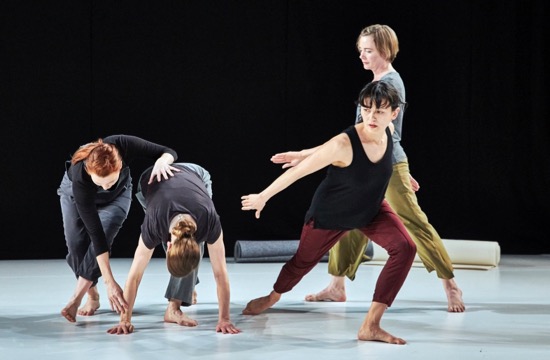
Bebe Miller’s In a Rhythm. (L to R): Angie Hauser, Bronwen MacArthur, Michelle Boulé, and (behind her) Sarah Gamblin. Photo: Robert Altman
The Making Room isn’t a dance, it’s a project devised by Bebe Miller that she and fellow choreographer Susan Rethorst have been working on for over a year via conversations both virtual and actual, plus convenings and rehearsals with their collaborating dancers wherever they could find space and time. A website (the makingroom.org) includes text, images, and video documentation of the process. The project has resulted in two works—Rethorst’s Stealing from Myself and Miller’s In a Rhythm—shown, along with video installations by Lily Skove and Ellen Maynard, at New York Live Arts this past week.
These dances have made me think about the term “making room” beyond its significance as a room in which things get made. It resonates with getting rid of what you no longer need in order to create a space in which new ideas can flourish. That thought in turn makes me ponder lost and found ideas in relation to cleaning out your closet or attic. You discover something you’d almost forgotten you had; maybe you give it away or toss it; maybe you ponder it, refurbish it, and give it new life.
“Excavate” was a word applied to the process in an thought-provoking essay, “Bebe Miller and Susan Rethorst: Archiving the Disappearing Dance.” Its author, choreographer, dancer, teacher, writer Meredith Bove saw the project develop at various stages. I hadn’t read the essay before the NYLA performance, although it was included in the press kit and can also be found at http://thinkingdance.net/. I came to the works bearing only my partial knowledge of these two dancemakers, who first met in the 1970s.
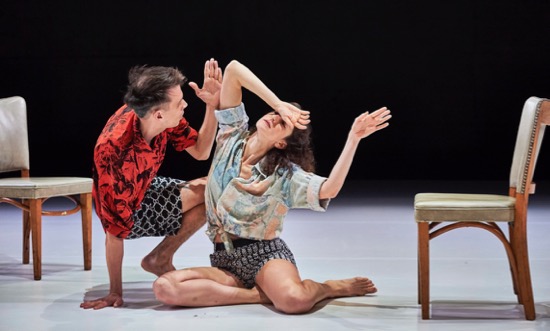
Gregory Holt and Gabrielle Revlock in Susan Rethorst’s Stealing from Myself. Photo: Robert Altman
Rethorst’s name for her dance is apt. In Stealing from Myself, Gabrielle Revlock and Gregory Holt replay moments from earlier works by Rethorst as well as showing movements and gestures that developed during the process of working together with the choreographer. The two inhabit a white-floored space, possessing only two chairs and several books. At times, Stan Pressner’s lighting colors it boldly, and Danny Elfman’s recorded score creates emphases, whether sharp or dreamy. Revlock and Holt, wearing brightly colored and patterned clothing, appear neither as lovers nor as adversaries (although he does drag her by the legs three times, leaving her briefly inert). Instead they present themselves as colleagues—sizing each other up and collaborating, each facilitating whatever the other seems to be planning.
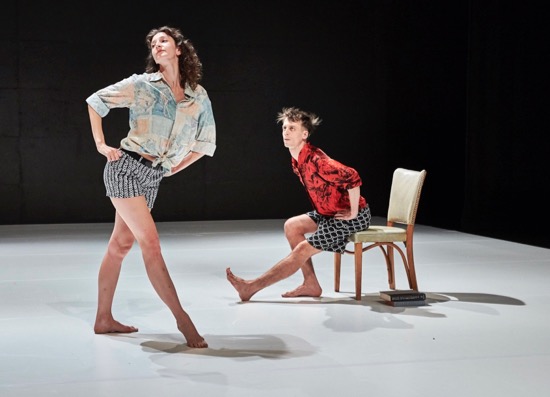
Gabrielle Revlock and Gregory Holt in Susan Rethorst’s Stealing from Myself. Photo: Robert Altman
Images, attitudes, and decisions flow together, anchoring, if at all, so swiftly that we don’t attempt interpretation; we simply absorb them. Revlock and Holt are intriguing to watch. They move their chairs closer together or farther apart. From time to time, they open, close, or re-pile the books. I don’t think they read anything, but I could be wrong. She puts a band around her hair, and he yanks it off in a single gesture. They bring their bodies together in considered, but precarious ways. He lies across two chairs, and she holds his leg. She sets a chair over him as he lies on the floor and sits on it; he knocks on the underside of its seat. She traces his outline on the air around him; he pays no attention. Sometimes, they dance in energetic unison; at other times, they seem to be holding movement conversations with invisible companions, or delivering separate speeches—all the while very close to each other, even interlocked. She hold her hands up as if framing a shot, but he, draped around her, doesn’t seem to be the subject.
Finally, Revlock picks up a book, opens it, and addresses us: “The End.” And it is.
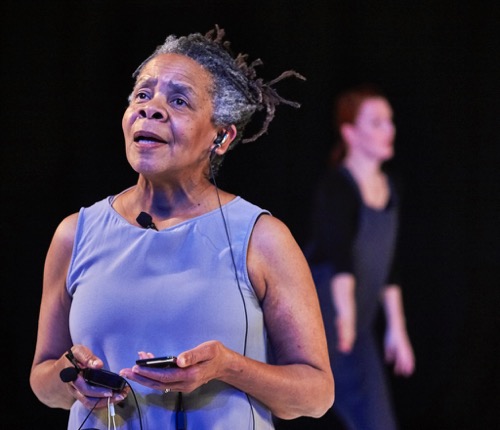
Bebe Miller in her In a Rhythm. At back: Angie Hauser. Photo: Robert Altman
Post-production- Robert Altman
Miller’s In a Rhythm is twice as long as the 35-minute Stealing from Myself (fascinated though I was, I caught myself glancing at my watch a couple of times). The piece is in some sense a re-framing of the familiar. Miller wanted, she wrote in a program note, “to look at the syntax of movement—how we collide with meaning through the juxtaposed dynamics of action and context, in time and space.” And her dance (with input from dramaturge Talvin Wilks) draws us into that collision.
Miller isn’t shy about revealing the readings that inspired aspects of her creative endeavor, both in the program and by her onstage. In various ways they make us think about meaning and misunderstanding and how the accrue. One is Astrid Lorange’s investigation of Gertrude Stein. Another is David Foster Wallace’s horrifying short story, “Incarnation of Burned Children.” In Miller’s program note, she advises, “Please find it and read it.” So I did (and perhaps you should too). She also brings up one of Toni Morrison’s appearances on Charlie Rose’s show, in which the writer calmly takes the interviewer to task on an often ignored example of racism: how come a person can ask her why she doesn’t write about white people, but no one asks a white author why he/she doesn’t write about black people? Emmett Till in his coffin is also mentioned
Sounds cut in, including intermittent music recorded by diverse artists: Leonard Cohen’s “Anyhow,” The Commodores’ “Brick House,” Nelly’s “Country Grammar,” and Donny Hathaway’s “More Than You’ll Ever Know.” There’s text, written by Miller and Angie Hauser and spoken with considerable thoughtfulness and wit by Miller (usually amid dancing). There are costumes by Liz Prince for the dance artists (seven including Miller), outfits that are mostly white, black, and gray at the outset incrementally flower into brightly colored equivalents, and, in the end, are again muted.
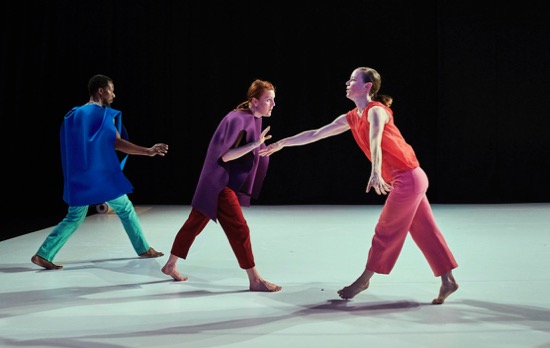
Bebe Miller’s In a Rhythm. L to R: Trebien Pollard, Angie Hauser, and Bronwen MacArthur. Photo: Robert Altman
There is also, of course, dancing. Some of it is unusual or quirky (Michelle Boulé, a marvelous presence in the piece, stands on one leg for quite a while, focused on turning the other bent one in and out, in and out—almost as if this were an automotive procedure). At other times, the finely designed movement is boisterous and athletic or smooth and slow. When two or three of the performers fall into unison, it’s a surprise, as if a current has picked them up and carried them along. They—creative collaborators all—are intent upon their tasks, whatever these may be.
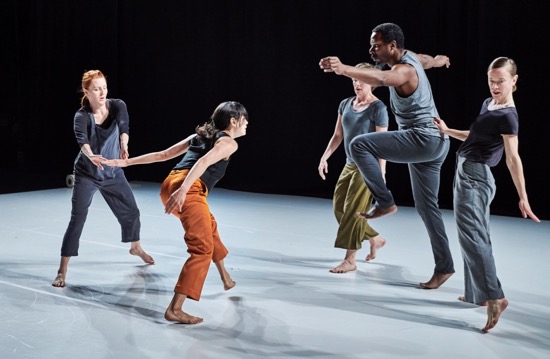
A confrontation (?) in Bebe Miller’s In a Rhythm. L to R: Angie Hauser, Michelle Boulé, Sarah Gamblin, Trebien Pollard, and Bronwen MacArthur. Photo: Robert Altman
As in Rethorst’s work, potent, enigmatic images emerge, scattered from some source we may not be familiar with. For a while, for instance, Sarah Gamblin stands apart, looking as if she’s trying not to cry; three of her colleagues watch her. Meanwhile, Bronwen MacArthur begins to dance wonderfully—her movement full and loose, curling through space; while she keeps going, drifting incrementally stage left, Trebien Pollard brings in a chair and bumps Gamblin into it. Often, while you’re watching the foreground, two or three performers may be quietly busy at the back of the stage. What do two portable islands of gray fabric stand for? Where do unrolled lengths of it lead? Why do some of the dancers deck themselves briefly in shawls of colored felt? I ask these questions only to dismiss them. No answers required. Pollard at one point drags himself awkwardly along on his hands, feet, and belly; before long Gamblin does it too. A tribal necessity as well as a compositional gambit?
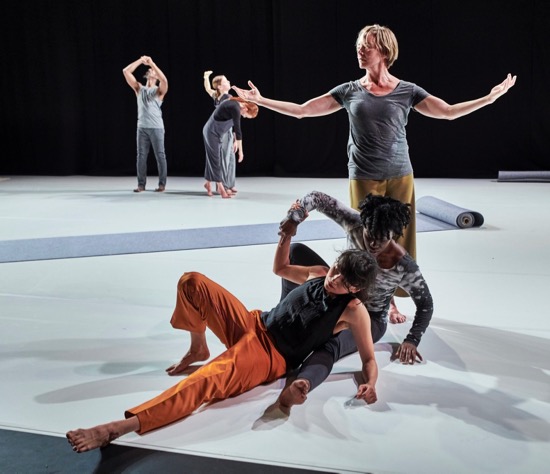
Bebe Miller’s In a Rhythm. Foreground (L to R): Michelle Boulé, Christal Brown, and Sarah Gamblin. At back: Trebien Pollard, Bronwen MacArthur, and Angie Hauser. Photo: Robert Altman
There are unexpected outbursts (Pollard’s takes you aback) and hints of confrontations. When people intersect, they may have different things on their minds. You can’t “track” Christal Brown, Houser, or the others mentioned, just watch their actions with interest. And those actions become a web that expands discreetly whenever Miller enters to talk to us with the kind of ease she might have were this small theater her living room. She and the expert performers make me think harder about syntax and how the significance of events and feelings may shift because of the way the “words” that reveal them are organized and deployed. The performance space becomes a “making place” in every sense.
